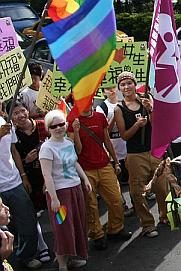
Exploring the history and experiences of mixed heritage persons and inter-racial relationships across the world

Exploring the history and experiences of mixed heritage persons and inter-racial relationships across the world

Queen Two on Tun Hwa South Road on Taiwan Pride 2005 including a young lady with albinism as a participant
Recently in the news, there was a story of an African couple who conceived a white baby. To many at first, the mother must have cheated on her spouse but later many believed the child to be an albino. However, this appeared not to be the case. The baby born to the Tshibangu family is said to have a slight genetic effect due to inheriting a set of genes from the parents that accumulated into a lighter, whiter skin tone. It is believed that 12 different genes influence skin colour. It is also possible that both parents have had European ancestors that they may be unaware of and this may have caused a throwback. This is not the first time that a similar case has come to the press’ attention, in 2010, there was another case within a Nigerian family but in that case albinism was not ruled out as it is the most common recessive disorder in Nigeria.
Albinism is a disorder from birth caused by the absence or a defect in the enzyme that helps in the production of melanin that colours mainly the skin but also the eyes and hair. It is recessive in that both parents must carry a copy of the genes and pass them onto the offspring for it to have a visible effect. The effects range from total lack of melanin to the colour of a pale white/European individual.
Speaking to a number of laymen, many believe that albinism is much more prevalent in black people particularly Africans. This is interesting as in popular culture, the ‘evil albino’ such as Silas in the book ‘The Da Vinci Code’, Zao in the James Bond movie ‘Die Another Day’ and the twins in the movie ‘The Matrix Reloaded’, are not portrayed as racially black people. The observation that albinism is most common amongst Africans is actually correct for type 2 of Oculocutaneous albinism.
There are two types of albinism, Oculocutaneous which affects skin, eyes and hair colour and Ocular albinism which is predominantly eye colour. There are four types of Oculocutaneous albinism of which type 2 is the most common and affects about 1 in 36,000 people regardless of race. However, amongst black populations, it affects 1 in 10,000 African Americans but is as high as 1 in 3,600 in Central and Southern Africa. Type 3 a lesser form which results in red hair, reddish-brown skin and blue or gray eyes appears to affect only black people of Africa and New Guinea (1 in 8,500). Type 1 albinism rarely affects black people but affects about 1 in 40,000 of other populations.
As in all societies, being different can be dangerous. Throughout sub-Saharan Africa where they are most prevalent, albinos have been on the receiving end of dangerous belief systems. In Zimbabwe, belief that sex with an albino woman will cure HIV is reported to have led to rapes and subsequent increase in HIV infection amongst albinos. In Central Africa, particularly in Tanzania, which is believed to have the highest population in the world, albinos have been killed and maimed for witchcraft. Kenya, the Congo and Burundi have all had witchcraft induced murder cases.
What is happening to the Albinos is a stark example of how being different combined with the lack or misuse of education can combine to lead people into doing horrendous things to each other. This is true of all societies and all prejudices including racism. Education is the key to eradicating such evils from the planet.